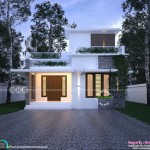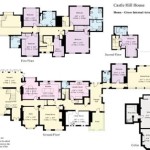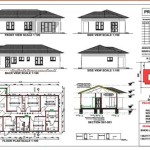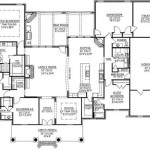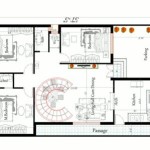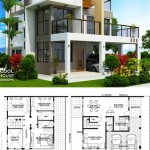Ultra Modern Contemporary House Plans: Designing for the Future
The architectural landscape is constantly evolving, and ultra modern contemporary house plans represent the cutting edge of residential design. These plans integrate innovative technologies, sustainable materials, and a minimalist aesthetic to create homes that are not only visually striking but also highly functional and environmentally conscious. This article explores the key characteristics, benefits, and considerations when choosing ultra modern contemporary house plans for a future-proof home.
Ultra modern contemporary house plans are defined by a convergence of design principles aimed at maximizing space, light, and efficiency. They often feature open floor plans, large windows, and clean lines, creating an airy and spacious atmosphere. The emphasis is on seamless integration between indoor and outdoor living spaces, accomplished through features like expansive patios, retractable walls, and integrated gardens.
These plans often incorporate smart home technology, allowing residents to control lighting, temperature, security, and entertainment systems with ease. Sustainability is also a core principle, with features like solar panels, rainwater harvesting systems, and energy-efficient appliances becoming increasingly common. The materials used in ultra modern contemporary homes are typically sustainable and durable, ranging from recycled steel and bamboo to reclaimed wood and concrete.
Key Characteristics of Ultra Modern Contemporary House Plans
Ultra modern contemporary house plans share several defining characteristics that set them apart from other architectural styles. These characteristics are not merely aesthetic; they contribute to the overall functionality, sustainability, and livability of the home.
Open Floor Plans: One of the most recognizable features of ultra modern contemporary designs is the open floor plan. This design concept eliminates or minimizes the use of interior walls, creating a seamless flow between living, dining, and kitchen areas. This promotes social interaction, facilitates natural light penetration, and provides a sense of spaciousness. Open floor plans often require careful consideration of zoning and furniture placement to define different areas within the larger space.
Large Windows and Natural Light: Ultra modern contemporary homes prioritize natural light, utilizing large windows, skylights, and glass walls to maximize solar gain and reduce the need for artificial lighting. These windows not only flood the interior with light but also offer panoramic views of the surrounding landscape, connecting the home to its environment. The strategic placement of windows is crucial to control heat gain and maintain privacy, often utilizing features like overhangs, shading devices, and strategically placed landscaping.
Clean Lines and Minimalist Aesthetic: Simplicity and clean lines are hallmarks of the ultra modern contemporary style. The focus is on form and function, with unnecessary ornamentation stripped away. This minimalist aesthetic extends to the interior design, with a focus on uncluttered spaces, neutral color palettes, and carefully selected furnishings. The goal is to create a serene and calming environment that promotes relaxation and well-being.
Flat or Low-Sloping Roofs: While not all ultra modern contemporary homes feature flat roofs, they are a common element. Flat roofs contribute to the clean, geometric lines of the design and can also be utilized for green roofs, solar panels, or rooftop terraces. Low-sloping roofs are another alternative, offering a similar aesthetic while providing better drainage than completely flat roofs. The roofing material is often chosen for its durability, energy efficiency, and aesthetic appeal.
Sustainable Materials and Energy Efficiency: Sustainability is a central tenet of ultra modern contemporary design. Homes are often constructed using sustainable materials such as recycled steel, bamboo, reclaimed wood, and concrete. Energy-efficient appliances, insulation, and HVAC systems are also integrated to minimize energy consumption. Passive solar design principles are often employed to maximize solar gain in the winter and minimize heat gain in the summer.
Benefits of Choosing Ultra Modern Contemporary House Plans
Opting for ultra modern contemporary house plans offers a range of benefits, extending beyond aesthetics. These benefits encompass improved functionality, enhanced sustainability, and a higher quality of life.
Enhanced Functionality and Livability: The open floor plans and seamless indoor-outdoor connections of ultra modern contemporary homes promote a more relaxed and social lifestyle. The abundance of natural light and thoughtfully designed spaces contribute to a sense of well-being. Smart home technology further enhances convenience and efficiency, allowing residents to control various aspects of their home with ease.
Increased Energy Efficiency and Sustainability: The focus on sustainable materials and energy-efficient technologies in ultra modern contemporary homes results in lower utility bills and a reduced environmental impact. Features like solar panels, rainwater harvesting systems, and green roofs can further enhance sustainability and reduce reliance on traditional energy sources. This not only benefits the environment but also saves homeowners money in the long run.
Higher Property Value: Ultra modern contemporary homes are often highly sought after by buyers, particularly in urban areas and desirable neighborhoods. Their unique design, sustainable features, and modern amenities can command a premium price compared to more traditional homes. Furthermore, the use of durable and high-quality materials ensures that these homes retain their value over time.
Adaptability and Flexibility: Ultra modern contemporary house plans are often designed with flexibility in mind. Open floor plans can be easily reconfigured to adapt to changing needs, and modular construction techniques allow for future expansion or modification. This adaptability ensures that the home can evolve with the homeowner's lifestyle and preferences.
Considerations When Choosing Ultra Modern Contemporary House Plans
While ultra modern contemporary house plans offer numerous advantages, it's crucial to consider several factors before making a decision. These considerations include budget, site constraints, local building codes, and personal preferences.
Budget Considerations: Ultra modern contemporary homes can be more expensive to build than traditional homes, due to the use of specialized materials, advanced technologies, and complex construction techniques. It's essential to establish a realistic budget and carefully consider the cost implications of various design choices. Working with an experienced architect or builder can help to optimize costs without compromising on quality or design.
Site Constraints and Orientation: The orientation and topography of the building site can significantly impact the design and energy efficiency of an ultra modern contemporary home. The placement of windows and the orientation of the building should be carefully considered to maximize solar gain in the winter and minimize heat gain in the summer. Site constraints such as slope, soil conditions, and existing vegetation may also require modifications to the design.
Local Building Codes and Regulations: Ultra modern contemporary designs may not always align with local building codes and regulations, particularly in areas with strict architectural guidelines. It's crucial to research local zoning regulations and building codes before finalizing the design. Obtaining necessary permits and approvals can be a time-consuming process, so it's important to factor this into the project timeline.
Personal Preferences and Lifestyle: While ultra modern contemporary design offers a distinct aesthetic, it's important to consider personal preferences and lifestyle needs. The minimalist aesthetic may not appeal to everyone, and the open floor plans may not be suitable for families who require more privacy. It's essential to choose a design that reflects individual tastes and complements the way the homeowner wants to live.
Maintenance and Upkeep: The use of specialized materials and technologies in ultra modern contemporary homes may require specific maintenance and upkeep procedures. For example, flat roofs require regular inspection and maintenance to prevent leaks, and specialized HVAC systems may require professional servicing. It's important to factor in the long-term maintenance costs when choosing materials and technologies.
Choosing the right ultra modern contemporary house plan requires careful consideration of various factors, including personal preferences, budget constraints, and site conditions. By understanding the key characteristics, benefits, and considerations of this architectural style, homeowners can create a home that is not only visually stunning but also highly functional, sustainable, and future-proof.

Modern House Plans 61custom Contemporary

50x62 Ultra Modern House Design Plan Elevation Architect Duplex Bungalow

30x40 Ultra Modern Attractive Bunglow Design Model House Plan Architectural Plans Small Exterior

Contemporary House Plans Modern Home The Designers

Modern House Floor Plans Check Out How To Build Your Dream Mansion Plan

Small House Plan Ultra Modern Plans For Arizona Floorplans

Contemporary House Plans Modern Home The Designers
Ultra Modern Home Designs Design

Modern Contemporary House Plans Courtyard Floor

Ultra Modern Live Work House Plan 61custom Contemporary Plans Farmhouse Floor

